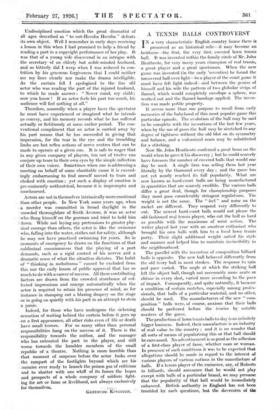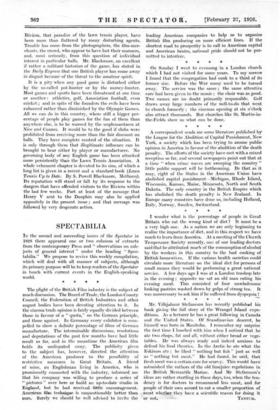A TENNIS BALLS CONTROVERSY
• TN a very characteristic English country house there is , -I- preserved as an historical relic—it may become an heirloom—the first, the very first, covered lawn tennis ball. It was invented within the family circle of Mr. John Heathcote, for very many years champion of real tennis, a great player and a great sportsman. When the new game was invented .(in the early 'seventies) he found the uncovered ball over light—to a player of the court game it . must have felt light indeed—and between the genius of ,; himself and his wife the pattern of two globular strips of flannel, which would completely envelope a sphere, was worked out and the flannel bandage applied. The inven- tion was made public property.
. It serves more than one purpose to recall from early . memories of the babyhood of this most popular game this particular episode. The evolution of the ball may be said to be complete with the inventions of the last few years, when by the use of gases the ball may be stretched to any degree of tightness without the old blot on its symmetry and balance, and a vulcanized seam may be substituted for a stitching.
Now Mr. John Heathcote conferred a great boon on the world when he gave it his discovery ;,, but he could scarcely have foreseen the number of covered balls that would one ,day be used. A single firm was selling them last year . literally by the thousand every day ;. and the game has not yet nearly reached its full popularity. What are :.now .known as hard-court balls are being manufactured _in quantities that-are scarcely credible. The various balls ., differ a great deal, though for championship purposes they must pass considerably stringent regulations. The .weight is not the same.. The " feel " and noise on the .racket are different. They respond very differently to cut. The newest hard-court balls would not please the old-fashioned real tennis player, who cut the ball as hard as possible with the maximum of wrist action. The writer played last year with an amateur enthusiast who brought his own balls with him to a local lawn tennis party. Their slight additional weight suited his style and manner and helped him to maintain invincibility in the neighbourhood.
The parallel with the invention of composition billiard balls is apposite. The new ball behaved differently from the old ivory ball in most strokes. The response to spin and pace varied. The angle at which the striking ball left the object ball, though not necessarily more acute or obtuse in every shot, varied more according to the pace of impact. Consequently, and quite naturally, it became a condition of certain matches, especially among profes- sionals, that balls of a particular material, and no other, . should be used. The manufacturers of the new " com- position " balls were, of course, anxious that their balk ,should be preferred before the ivories by notable -masters. of the game.
The production of lawn tennis balls to-day is an infinitely bigger business. Indeed, their manufacture is an industry of real value to the country ; and it is no wonder that all sorts of means of popularizing this or that ball should be canvassed. No advertisement is so good as the adhesion of a first-class player of fame, whether man or woman. In presence of such conditions it was to be expected that allegations should be made in regard to the interest of . various players of various nations in the manufacture of .balls. If a tennis player of the eminence, say, of Roberts in billiards, should announce that he would not play .except with balls of a particular brand, we.may presume that the popularity of that ball would be immediately enhanced. British authority in England has not been troubled by such questions, but the dovecotes of the Riviera, that paradise of the lawn tennis player, have been more than fluttered by many disturbing agents. Trouble has come from the photographers, the film-mer- chants, the crowd, who appear to have lost their manners, and, most seriously, from this question of individual interest in particular balls. Mr. Blackmore, an excellent if rather a militant historian of the game, has stated in the Daily Express that one British player has come away in disgust because of the threat to the amateur spirit.
It is a pity when any good game is disturbed either by the so-called pot-hunter or by the money-hunter. Most games and sports have been threatened at one time or another : athletics, golf, Association football, even cricket ; and in spite of the founders the evils have been enhanced rather than diminished by the Olympic Games. All we can do in this country, where still a bigger per- centage of people play games for the fun of them than anywhere else, is to be warned by the unpleasantness at Nice and Cannes. It would be to the good if clubs were prohibited from receiving more than the fair discount on balls. They have complete control of the situation. It is only through- them that illegitimate influence can be brought to bear either by player or manufacturer. No governing body of affiy English game has been attacked more persistently than the Lawn Tennis Association. A whole vehement chapter is devoted to its sins, of which a long list is given in a recent and a standard book (Lawn Tennis Up to Date. By S. Powell Blackmore. Methuen). Its reputation will stand or fall by its response to the dangers that have offended visitors to the Riviera within the last few weeks. Part at least of the message that Henry V sent to the Dauphin may also be applied appositely in the present issue ; and that message was followed by very desperate action.























































 Previous page
Previous page